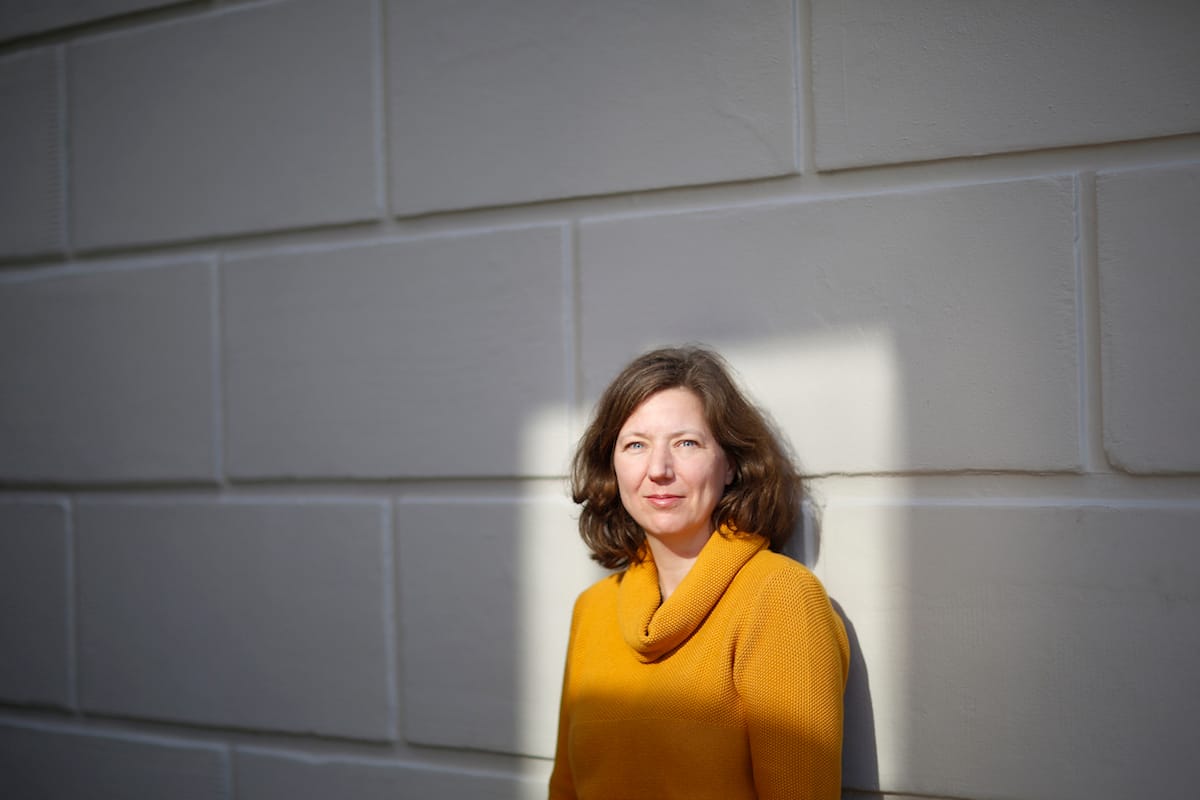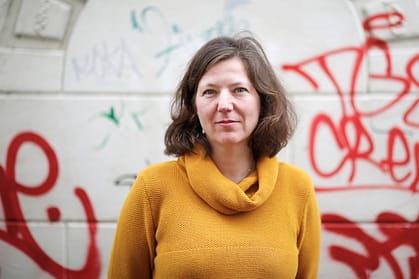
How saying the first thing that “comes to mind” makes us fluent speakers
An interview with Simone Sprenger
In natural language, people often use multi-word expressions such as “by and large” or “all of a sudden”. Despite the incongruity between the form and meaning of such utterances, the use of multi-word expressions is thought to reduce processing effort during speech. Dr. Simone Sprenger is an assistant professor in Psycholinguistics in the Faculty of Arts and investigates how these multi-word expressions are retrieved from the mental lexicon while people speak. By using eye tracking research, she dives deep into the question of how multi-word expressions contribute to fluency in speech.
As a student, you moved from Germany to the Netherlands. After finishing your studies in cognitive psychology at the Radboud University in Nijmegen, you continued into a PhD project on the production of idioms, sayings such as “to break the ice”. What made you choose to study idioms?
Already as a master’s student, I was mostly interested in language production. For my master’s thesis, I did a project on the incremental planning of speech. While people speak, they are already thinking about the next thing they are going to say. In my master’s thesis research, I specifically looked into the way in which the grammatical form of an utterance depends on the availability of information while we are planning ahead. Besides the fact that I got intrigued by the planning of speech, I also liked language production because it is such an understudied field: most language research is focused on comprehension. In comprehension studies, a researcher can more easily manipulate what a listener or reader processes by adjusting the linguistic input to the phenomenon he or she is investigating. In language production studies this is far more difficult, because you cannot completely control what someone is planning to say – resulting in all sorts of methodological challenges. I have studied idioms, or the more general category of multi-word expressions (e.g., “by and large”) as their production is an ideal testing ground for language production theories. You can contrast the production of fixed multi-word utterances to multi-word utterances that are generated on the fly.
In collaboration with Pim Levelt and Gerard Kempen, you developed the superlemma hypothesis to explain the mechanism underlying the production of multi-word expressions, such as idioms. Can you tell something about this model and explain what its strengths are compared to other models of the production of multi-word expressions?
My thesis project focused on unraveling how multi-word expressions are retrieved from the mental lexicon while planning speech. The model that we constructed is closely related to the model of Levelt on lexical access during speech production. A major challenge was to develop experiments to empirically test the validity of the new model.
Our model was designed in such a way that it can explain both comprehension and production, even though it is based on a production theory. For me, it is very important to keep in mind that we have only one mental lexicon, and that a division in production and comprehension tasks is very artificial. By just introducing a single addition to an existing model, namely a “superlemma” node representing the multi-word expression, we can elegantly explain the observed empirical results. Although the model also predicts how multi-word expressions are comprehended, this is something that still needs to be tested empirically. I am very happy that NWO recently funded a PhD project that can shed new light on this assumption.

“I now realize that my personal experience can actually benefit me in my work as a scientist.”
At some point in your career, your research interest expanded to the field of bilingualism. How did this happen?
My interest in bilingualism partly results from my personal experience of learning Dutch after moving to the Netherlands. However, regardless of my own experiences, I have always been interested in bilingualism, but never incorporated the topic in my scientific work until I started working in the Vici project of Monika Schmid. This project was a great opportunity for me to combine my interest in bilingualism with my scientific work, as it allowed me to work on grammatical processing, and both language production and comprehension in bilinguals. I also got the opportunity to work on a bilingualism project with Kees de Bot, Wander Lowie, and Nienke Houtzager. Studying bilingualism is not just interesting from a language point of view, but I am also intrigued by the reported observations that bilingualism has a positive effect on one’s cognitive abilities. Nevertheless, even if this turns out to be a reliable finding, what could be the mechanisms behind it?
Does the fact that you are a bilingual/second language speaker in daily life yourself help you in thinking about your research or being creative?
I think so, because I know what it is like to be bilingual: the constant work-arounds when you don’t know the right words, but also the fun of easily switching between languages. However, this does not mean that as a monolingual person you cannot do research on bilingualism. In the past, I have refused to do research on bilingualism for a long time, because to me it felt too much like doing research about myself. I now realize that my personal experience can actually benefit me in my work as a scientist. I have experienced myself in which aspects different languages can conflict with each other. This for example happens when after a long day of work, I sit at the kitchen table and start mumbling something incomprehensible. At this moment my Dutch husband often asks me: “Ah, German I suppose?”

“Studying bilingualism is not just interesting from a language point of view, but I am also intrigued by the reported observations that bilingualism has a positive effect on one’s cognitive abilities.”
At the moment you are planning an experiment on disfluencies and processing effort in the production of idioms. How did you come up with the idea to combine the topic of disfluencies with your research on the production of multi-word expressions in general?
This project indeed is based on a combination of factors that interest me. For the experiment I mostly got my inspiration by the research of Andrew Pawley and Frances Hottgets Syder that was done in the early 80s. To a certain degree, the superlemma model is a formal specification of Pawley and Syder’s ideas about the types of linguistic units that we store in long-term memory. They pointed out that second-language learners often lack knowledge about multi-word expressions and suggested that this is a major factor for the degree to which they are perceived as native-like. Not only because they don’t use a multi-world expression where native speakers would have used one, but also because they are often much less fluent. This means that the use of multi-word expressions can be seen as a form of language proficiency. At the same time multi-word expressions make it easier to speak fluently, because they should reduce processing effort. In this way, the link between bilingualism, multi-word expressions, and disfluencies is quite straightforward. In a first corpus study, we indeed found that the number of disfluencies and the number of multi-word expressions in spontaneous speech correlate negatively, supporting the link between multi-word expressions and fluency. In the coming year, I want to explore whether we can experimentally demonstrate that knowledge and use of multi-world expressions makes a speaker more efficient.
Recently, you were appointed as an assistant professor in Psycholinguistics in the Faculty of Arts. This means that you are also teaching besides doing research. Do you try to incorporate your research interests in your teaching and if so, how do you do this?
Yes, I do. I believe that teaching is much more effective if a researcher can incorporate his or her drive and passion for the field. This actually reflects the idea behind scientific education: researchers providing education to their students based on their own expertise and experience. Although it is often more difficult to incorporate ongoing research into courses for first-year students, I always try to include bits and pieces of my projects. By providing students with examples of real experiments, it makes the topics more concrete and, hopefully, I trigger their interest. What I like most, are courses in which teaching and research go hand in hand. I teach a third-year Bachelor’s course in which students set up and carry out experiments on multi-word expressions. By incorporating my research interest in my teaching, I hope to pass on my enthusiasm to the students and in this way make them enjoy the course too.
As an assistant professor in Psycholinguistics you have also become a member of the BCN Research School. The research carried out within BCN is highly interdisciplinary. Do you think that at the research that is performed in the Faculty of Arts is of a sufficiently interdisciplinary character?
In the area of psycholinguistics, our work is by definition multidisciplinary. In my work, I combine methods, techniques, and knowledge form linguistics, psychology, and neuroscience. BCN provides an excellent context for extending these collaborations to other fields. For example, I have been discussing potential collaborations with researchers from the department of biology, as communication is also an important topic in their field. So I would find it very interesting to think about a BCN course in which aspects of communication and language use is discussed from the perspectives of the different fields of BCN. This could bring together the biological and linguistic approaches to language, and strengthen linguistic research by gaining insights in language from different fields of expertise.



